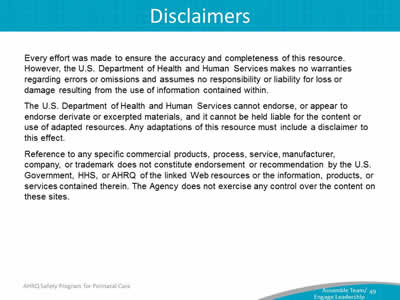Assemble the Team and Engage Leadership for Perinatal Safety: Facilitator Guide
AHRQ Safety Program for Perinatal Care
Slide 1: Assemble the Team and Engage Leadership for Perinatal Safety

Say:
The Assemble the Team and Engage Leadership module of the AHRQ Safety Program for Perinatal Care addresses team composition within the labor and delivery or L&D unit. This module will help you understand five concepts: the importance of teamwork and team composition, developing a strategy to build an effective team, defining the roles and responsibilities of team members, identifying the characteristics of successful teams, and identifying barriers to team performance using the tools of CUSP, the Comprehensive Unit-based Safety Program.
Slide 2: Learning Objectives

Say:
In this module, we will—
- Address the importance of your team.
- Develop a strategy to build a successful team.
- Identify the characteristics of effective teams and barriers to their performance as identified in TeamSTEPPS®.
- Describe the roles and responsibilities for team members.
Slide 3: The L&D Unit-Based CUSP Team

Say:
To ensure a successful program, the team should be actively involved, willing to spread the interventions, and committed to sustaining the gains across the L&D unit. Remember that achieving the goals of the intervention rests with the team.
To encourage efficient implementation, all team members should understand and apply the following concepts:
- Culture is local.
- The team is composed of engaged frontline providers who take ownership of patient safety.
- The team includes members with different levels of experience.
- The team is tailored to include members based on the specific L&D intervention.
- The team meets regularly.
- The team has access to resources necessary for the intervention.
Slide 4: Success Depends on L&D Unit Team

Say:
The success of the Safety Program for Perinatal Care will depend on the L&D unit team. The individuals who comprise the team are responsible for starting and sustaining the initiative, so their engagement and belief in the project will greatly contribute to its positive results.
To embody the local culture of the L&D unit, the team should also include frontline providers with varying backgrounds and clinical expertise. The members of the L&D unit team will apply their wisdom and background to engage other team members, develop educational materials, and execute the project.
Slide 5: Team Members

Say:
Key L&D unit CUSP team members include—
- Nurses, including educators,managers, midwives, anesthetists,nurse practitioners, and L&D staff nurses.
- Physicians, including obstetricians,family medicine doctors, pediatricians,and anesthesiologists.
- Senior executives.
Additional members who would be helpful to involve in the initiative are—
- Pharmacists.
- Patient safety officers.
- Chief quality officers.
- Ancillary or support staff.
- Infectious disease specialists (if applicable)
The key team members—nurses, physicians, and senior executives—will help ensure the initiative is used effectively. However, input from other unit or hospital specialists is needed.
Slide 6: Team Characteristics

Say:
CUSP and TeamSTEPPS present similar approaches to team assembly and composition.
CUSP stresses that unit teams should—
- Have diverse local "opinion leaders" and dissenters.
- Be willing to help spread the initiative.
Slide 7: Team Characteristics

Say:
TeamSTEPPS emphasizes that unit teams should—
- Develop a strong sense of collaborative trust and confidence.
- Manage and optimize performance outcomes.
- Develop a strong sense of collective trust, team identity, and confidence.
Slide 8: Team Characteristics

Say:
CUSP and TeamSTEPPS both state that unit teams should—
- Have strong team leadership.
- Have defined roles and responsibilities.
- Maintain clear values and a share division.
Slide 9: Team Characteristics

Say:
Unit teams should also contain mechanisms for collaboration and feedback, such as—
- Provide mutual feedback regularly as a team.
- Establish and revise team goals and plans.
- Differentiate between higher and lower priorities.
- Have mechanisms for anticipating and reviewing team members' issues.
- Review team effectiveness periodically, including its outcomes, processes, and vitality.
- Identify teamwork and task requirements.
- Distribute and assign work thoughtfully.
- Integrate new team members consciously.
Having a strong unit team in place will help your unit reduce clinical errors, improve patient outcomes, improve process outcomes, and improve patient and staff satisfaction.
Slide 10: Team Member Characteristics

Say:
CUSP stresses that unit team members—
- Have a positive outlook.
- Are dedicated to the team's initiative.
- Have broad vision,.
- Are detail oriented.
Slide 11: Team Member Characteristics

Say:
TeamSTEPPS stresses that team members—
- Provide quality information and feedback.
- Manage conflict skillfully.
- Perform well as a group to reduce stress among team members.
Slide 12: Team Member Characteristics
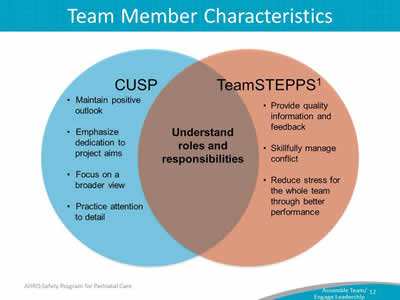
Say:
CUSP and TeamSTEPPS both emphasize that team members understand their roles and responsibilities.
CUSP and TeamSTEPPS rely on the interest and skills of team members, from project inception, through intervention, and into project sustainability.
Slide 13: Building Your CUSP Team
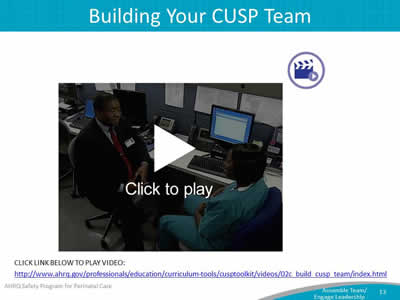
Do:
Play the video.
https://www.ahrq.gov/hai/cusp/videos/02c-build-cusp-team/index.html
Ask:
- What reasons does the nurse manager give the senior executive for having a physician champion?
- What hospital staff members will be recruited to the CUSP team?
- Why does the nurse manager want the responsibility for the work to remain at the unit level?
Slide 14: CUSP Teams' Group Processes
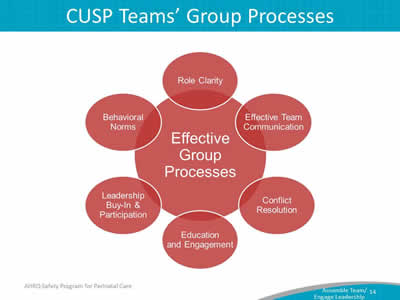
Say:
Effective group processes for CUSP teams include:
- Role clarity.
- Effective team communication.
- Conflict resolution.
- Education and engagement.
- Senior leadership buy-in, and support.
- Norms.
Successful L&D unit teams have reliable processes in place for team members to work and communicate efficiently. Effective group processes provide opportunities for L&D unit teams to hone their skills in the areas of leadership, role clarity, and development of shared interests, as well as collaboration and feedback.
Effective group work requires that all members share responsibility for group decisions and group interaction while working together on the Safety Program for Perinatal Care.
Slide 15: Team Performance
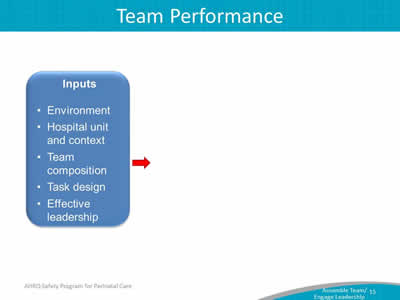
Say:
The L&D unit team's performance will determine the effectiveness of the CUSP for L&D initiative. Bearing this in mind, the inputs, processes, and outputs the L&D unit team encounters are interconnected and influential in team development.
The L&D unit team's performance will be influenced by the—
- Environment.
- Hospital unit and context.
- Team composition.
- Task design.
Environmental factors affect the implementation and sustainability of the initiative.
Depending on staff composition, the engagement of L&D unit team members may need to be adjusted to satisfy the context of the initiative. Applying a multidisciplinary approach when recruiting team members will affect the quality of interventions the unit team carries out. Seeking team members from varying clinical backgrounds and with different levels and types of experience will help tailor the CUSP to the needs of the unit. Devoting attention to task design will contribute to the success of the initiative.
Slide 16: Team Performance
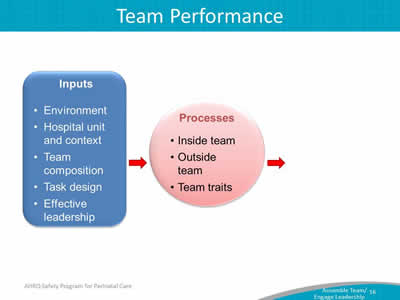
Say:
As well as the inputs, processes alter the outcome of any initiative. These processes may require interactions that take place inside the team (internal) or outside the team (external) or involve team traits.
Internal team processes focus on the resources the team developed to organize and manage the workload. External team processes involve the procedures the team carried out to put the initiative in action across the L&D unit.
Slide 17: Team Performance
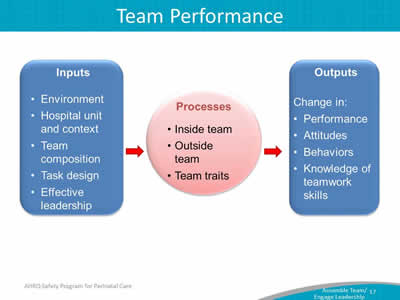
Say:
The qualities of the unit team and leadership will determine the results of the intervention within the unit, whether the intervention is successful or must be delayed, and the general direction of the CUSP for L&D initiative. Depending on the inputs and processes of the CUSP team, the team's outputs effect a change in staff performance, attitudes, and behaviors.
Bearing in mind that unit team inputs, processes, and outcomes are interconnected, teams will be able to modify their initiative to fit the needs of their L&D unit. In doing so, they are ensuring the sustainability of the initiative and developing processes that will help support its goal.
Slide 18: Barriers to Team Performance
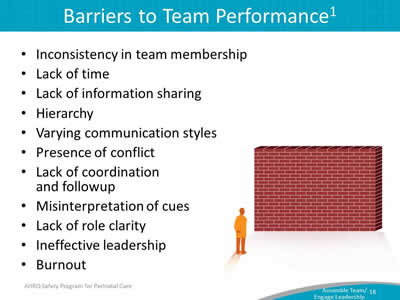
Say:
Barriers to team performance include—
- Inconsistent team membership.
- Lack of time and information sharing.
- Hierarchy.
- Varying communication styles.
- Conflict.
- Lack of coordination and follow up.
- Misinterpretation of cues.
- Lack of role clarity.
- Ineffective leadership.
- Burnout.
CUSP and TeamSTEPPS identify similar barriers to team performance. Inconsistency in team membership limits the strength and resiliency of the unit team. Teams that lack sufficient structure with a wide variety of input or that lack fully involved members will encounter difficulties with their performance. Teams that do not or are unable to devote the necessary time and energy to the initiative will also run into challenges with functionality. Time commitments should be shared equally among unit team members.
Hierarchy may impede unit team success by limiting opportunities for communication and interaction. If team members feel intimidated, the outcome of the initiative will be diminished.
Additional barriers to successful teamwork are conflict, lack of coordination, misinterpretation of cues, and lack of role clarity. While disputes are common when working in groups with diverse opinions, it is important to remember that conflict resolution and team interaction will help strengthen the initiative. Maintaining clear roles and task coordination will alleviate task or labor duplication, further promoting the success of the initiative.
Slide 19: Stages of Engagement
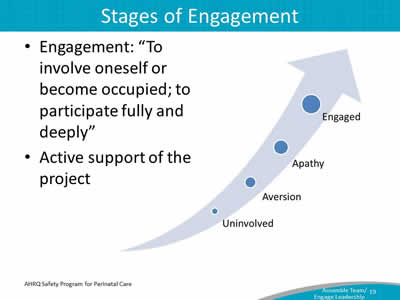
Say:
CUSP defines engagement as "to involve oneself or become occupied; to participate fully and deeply." Full engagement in the initiative will require L&D unit teams to actively support the project and its goals.
As exemplified by the upward sweeping arrow, the stages of engagement while assembling a CUSP team may include feeling uninvolved, aversion, apathy, and fully engaged. When L&D unit teams are fully engaged in the program, their performance improves, and the overall likelihood of the initiative's success increases.
Ask:
How can you involve unit staff members in the initiative? How will you maintain their interest in and support of the project?
Slide 20: Engage Team Members Using the 4 Es

Say:
The 4 Es engagement model will assist in identifying and recruiting team members. Created by the Johns Hopkins University's Quality and Safety Research Group, the 4 Es help teams implement patient safety interventions by focusing change efforts around technical and adaptive work. The model features four elements for starting and sustaining initiatives: engage, educate, execute, and evaluate. These four elements depict the primary means for engaging L&D unit team members to ensure perinatal safety initiatives are carried out in a way that encourages sustainability.
Slide 21: Engage Team Members Using the 4 Es
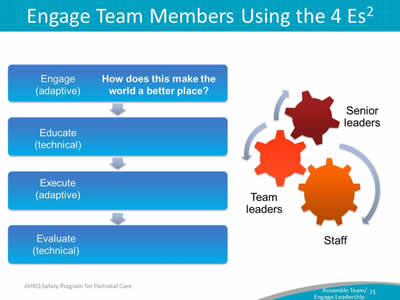
Say:
Engage
Engagement primarily embodies adaptive work, in which L&D unit teams help staff understand the results of preventable harm caused by a clinical problem. This is done by sharing stories about patients affected by a problem and estimating the number of patients who are harmed. Emphasizing unit team members' involvement in improving the L&D unit lends not only to the success of the initiative but also to the sustainability of the effort.
Slide 22: Engage Team Members Using the 4 Es
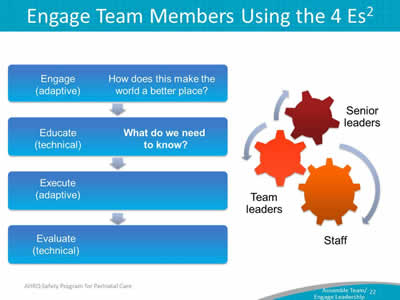
Say:
Educate
Education uses predominantly technical work and requires L&D unit teams to guarantee that staff and senior leaders understand what is necessary to prevent a given clinical problem.
Slide 23: Engage Team Members Using the 4 Es
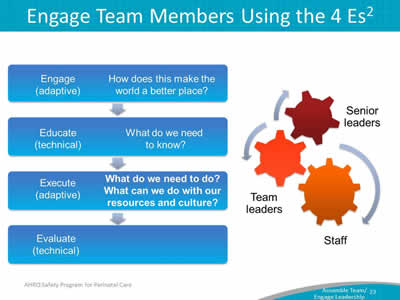
Say:
Execute
Execution of a sustainable intervention requires adaptive work. L&D unit team members will apply a plan of action based on the unit's resources and culture and analyze their roles within the plan.
Slide 24: Engage Team Members Using the 4 Es
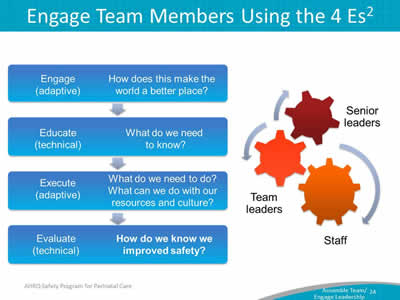
Say:
Evaluate
Evaluation is technical work and requires that the L&D unit team collect and submit data to analyze the success of an initiative. In addition to data submission, this work requires unit team members to ask themselves, "How do we know we improved safety?"
Slide 25: The CUSP Leader's Role
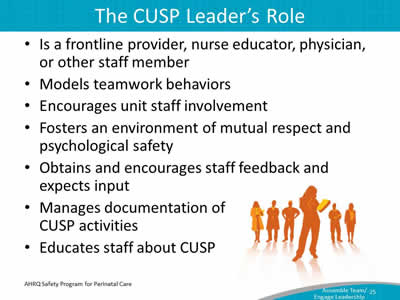
Say:
Now we will explore some of the CUSP team members' role. We will start with the team leader. This individual will—
- Be a frontline provider—a staff nurse, nurse manager, nurse educator, or physician.
- Model teamwork behavior.
- Encourage L&D unit staff involvement.
- Obtain and encourages staff feedback and expects input.
- Manage documentation of Safety Program for Perinatal Care activities.
- Educates staff about CUSP for application within the L&D unit.
The team leader serves as the unit's primary contact for CUSP within L&D. This individual w ill organize and lead the team, articulate clear goals, make decisions using the collective input of team members, and promote and facilitate good teamwork and promptly disseminate information to the CUSP team.
As a frontline provider, the leader should be familiar with the hospital staff's interests and needs. The leader's perspective on the initiative and its outcomes will endorse the sustainability of the project and provide other team members such as senior executives with the opinions and needs of frontline providers. The leader is responsible not only for recruiting L&D unit staff to participate in the initiative but also for maintaining unit staff interest and involvement after the initial excitement about the initiative has faded. The leader will need to be aware of and attuned to the unit staff's interests and needs. The leader will also be accountable for obtaining and analyzing unit staff feedback related to the program.
Ask:
Can you identify a potential project leader at your hospital who fits these characteristics?
Slide 26: Engage Physicians on the CUSP Team
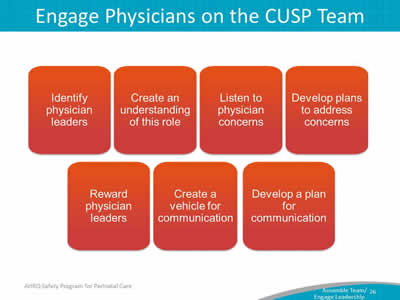
Say:
When developing a CUSP team, it is crucial to engage physicians to work closely with members of the L&D unit team. The physician champion who is recruited for CUSP must be capable of communicating and collaborating effectively with nurses, senior executives, and other team members participating in the initiative.
When engaging physicians on a CUSP team, it is important to—
- Identify physician leaders.
- Create an understanding of this role.
- Listen to physician concerns.
- Develop plans to address concerns.
- Reward physician leaders.
- Create a vehicle for communication.
- Develop a plan for communication.
Recruiting physicians to join the initiative will depend on the team leader's ability to tailor the program to match the physician leaders' interests and experience. Identify mutually important goals—that is, team goals that are meaningful to physicians' practice.
Slide 27: The Physician Champion's Role
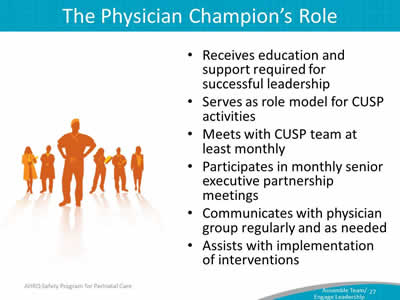
Say:
The physician champion is charged with advancing the initiative, bridging any communication gaps, and securing the buy-in of other physicians to participate in the CUSP initiative. Physician champions—
- Serve as role models for CUSP activities.
- Meet with the CUSP team at least monthly.
- Participate in monthly senior executive partnership meetings.
- Communicate with physician groups as needed.
- Help carry out initiatives.
The physician champion typically advocates and supports the initiative, providing the perspective of L&D unit physicians. They assist the CUSP team by educating and communicating with their physician peers to further the aims of the initiative and ensure the L&D unit physicians are involved with the program.
The physician champion is the physician equivalent of the nurse opinion leader or nurse manager on the CUSP team. We will discuss those roles in a few moments.
The physician champion also serves as the communication link between L&D unit physicians and the team. Physicians on the L&D unit have access to the physician champion to voice their concerns and needs. The physician champion attends meetings with the CUSP team at least monthly to help advance the initiative and take an active role in the unit team's efforts. In addition to these meetings, the physician champion also joins monthly senior executive partnership meetings.
The physician champion plays a critical role in ensuring the hospital physicians are on the same page as the project lead. The physician champion functions as the leader for L&D unit and hospital physicians while contributing to the initiative. Physicians not serving on the CUSP team can look to the physician champion for guidance and support when implementing the intervention.
Ask:
Can you identify a potential physician champion at your hospital who fits these characteristics and would be a good candidate to participate in a CUSP team?
Slide 28: Physician Engagement
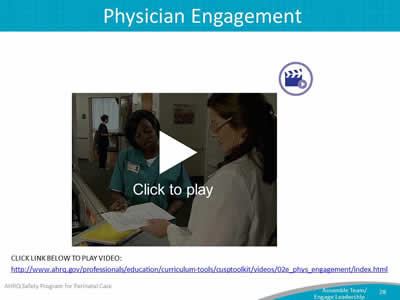
Do:
Play the video.
https://www.ahrq.gov/hai/cusp/videos/02e-phys-engagement/index.html
Ask:
What does the nurse manager suggest the physician champion do to engage other physicians on the unit?
Slide 29: Engage Other CUSP Team Members
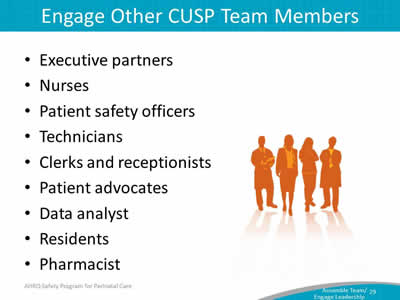
Say:
Engaging team members and other frontline providers will help sustain the effects and success of CUSP. As mentioned earlier, other team members may include, but are not limited to—
- Executive partners.
- Nurses.
- Patient safety officers.
- Technicians.
- Clerks and receptionists.
- Patient advocates.
- Data analyst.
- Residents.
- Pharmacists.
When enlisting additional CUSP team members, identify the local opinion leaders within these unit roles. The opinion leaders are usually the go-to people for others in the L&D unit. They do not judge or belittle peers' concerns and are willing to collaborate with peers to get answers to questions or address concerns. These individuals are excellent additions to the CUSP team because they will serve as the unit wide representative for their practice area on the CUSP L&D team.
For example, a nurse opinion leader can serve as the representative for all L&D unit nurses on the CUSP team. This individual will deliver the concerns and needs of L&D unit nurses to the CUSP team, disseminate the action plan, help unit nurses understand their role within the initiative, and address the interests of the L&D unit nurses at CUSP team meetings.
Slide 30: The Senior Executive's Role
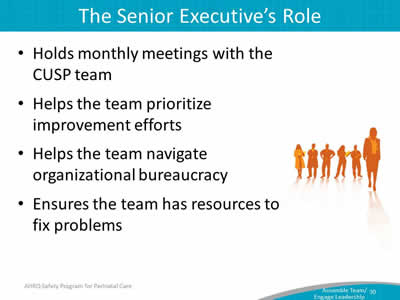
Say:
The senior executive is the executive leader who partners with the CUSP team and takes an active role in the Safety Program for Perinatal Care. The senior executive's direct link with other hospital executives helps guarantee the initiative is taken seriously hospital wide and the project remains an organizational priority.
The senior executive—
- Holds monthly meetings with the CUSP team.
- Helps the team prioritize improvement efforts.
- Helps the team navigate organizational bureaucracy.
- Ensures the team has resources to fix problems.
Slide 31: The Senior Executive's Role
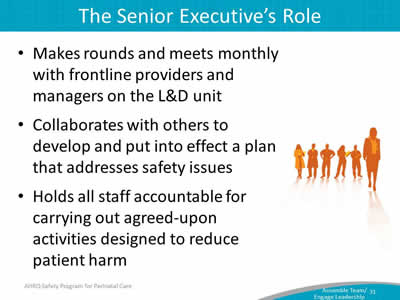
Say:
- To fully understand the needs of the CUSP team, senior executives need to meet regularly with the team members and complete rounds with the L&D unit team.
The senior executive—
- Collaborates with others to develop and put into effect a plan that addresses safety issues the L&D unit staff identify.
- Holds all staff accountable for carrying out agreed-upon activities designed to reduce patient harm.
The senior executive helps the team navigate the organizational bureaucracy that may exist within the hospital. Using organizational ties and influence, the senior executive is able to secure attention from other hospital executives, outside agencies, and even local and State government leaders to enable the success of the initiative. Senior executives can also help secure supplies, funds, and staff resources.
Slide 32: Senior Executives Support Both Technical and Adaptive Work of Change
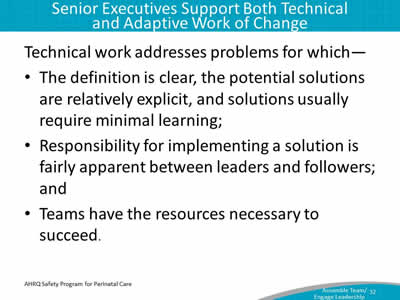
Say:
The senior executive should understand that change requires both technical and adaptive work. The technical work of change includes addressing problems for which—
- The definition is clear, the potential solutions are relatively explicit, and solutions usually require minimall earning.
- Responsibility for implementing a solution is fairly apparent between leaders and followers.
- Teams have the resources necessary to succeed.
Technical solutions to problems are often straightforward and easy to put in place. They may require the application of new procedures, training, or data collection methods; however, they require very little cultural or attitude change to be successful.
Slide 33: Senior Executives Support Both Technical and Adaptive Work of Change
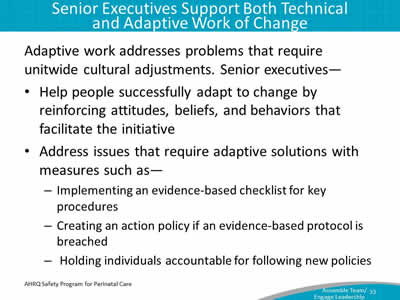
Say:
Adaptive work addresses problems that require unit wide cultural adjustments. Effective senior executives help people successfully adapt to change by reinforcing attitudes, beliefs, and behaviors that facilitate the initiative. Possible ways to address issues that require an adaptive solution are implementing an evidence-based checklist for key procedures, creating an action policy if an evidence-based protocol is breached, and holding individuals accountable for following new policies.
Slide 34: Senior Executives Support Both Technical and Adaptive Work of Change
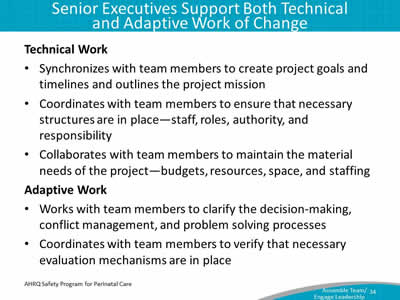
Say:
When engaging team members with technical and adaptive work, senior executives should know how to collaborate with their L&D unit team members to support both types of work. Senior leaders should be able to work with team members to—
- Create project goals and timelines and outline the project mission.
- Confirm necessary structures are in place.
- Maintain the material needs of the project.
- Verify the decision making, conflict management, and problem-solving processes are clear.
- Ensure necessary evaluation mechanisms are in place.
By collaborating with their CUSP team members to guarantee clarity with project timelines and deadlines or, if necessary, that materials and resources are in place, senior executives are initiating the technical work of change.
Senior executives conduct adaptive work when partnering with CUSP team members to establish that essential structures exist for project success, including evaluation mechanisms and decisionmaking processes.
Despite their differences in solution applicability, technical and adaptive work involve L&D unit team members in initiatives, regardless of their position or title within the L&D unit.
By cooperating with their CUSP team members on elements of project management, senior executives are able to build an environment in which communication among L&D unit team members is welcome and candid.
Slide 35: Senior Executive Collaborates To Develop and Implement a Plan Addressing Safety Issues
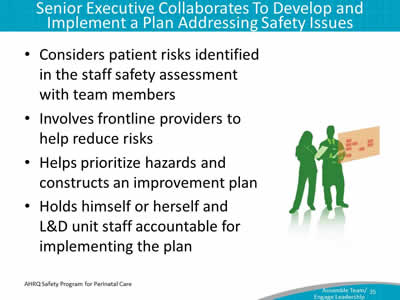
Say:
After determining technical and adaptive concerns, senior executives will be able to collaborate with their L&D unit team members to implement solutions.
The senior executive should—
- Work with team members to consider patient risks identified in the Staff Safety Assessment, which is discussed later in this module, or through a voluntary reporting system.
- Involve frontline providers to help reduce risks.
- Help prioritize risks and develop an improvement plan.
- Hold himself or herself and L&D unit staff accountable for implementing the plan.
By addressing patient risks identified, senior executives are partnering with their teammates to tackle risks at the L&D unit level. Further, when prioritizing risks and developing an improvement plan with the team, senior executives can help allocate resources as part of the solution.
Slide 36: Senior Executive's Characteristics
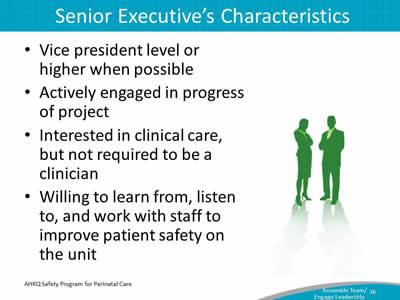
Say:
For the CUSP team and the project to function at optimal effectiveness, the senior executive should be—
- A vice president or higher ranking officer whenever possible.
- Actively engaged.
- Interested in clinical care.
- Willing to listen, learn, and work with staff to improve patient safety and the quality of health care delivery in the unit.
Executive team members need to be in a high enough position to authorize the use of required resources to help L&D unit-based teams resolve their perinatal safety issues. Their involvement with the CUSP initiative should not be based primarily on their availability to participate in meetings. The senior executive within the CUSP team should have a genuine interest in the initiative and be actively engaged in the team's efforts.
Ask:
Can you identify a senior executive at your hospital who fits these characteristics and would be a good candidate to participate in an L&D CUSP team?
Slide 37: The Challenges of Partnering With a Senior Executive
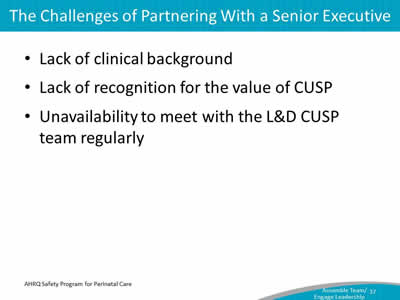
Say:
When engaging a senior executive member on a CUSP team, you may encounter the following hurdles:
- Lack of clinical background.
- Lack of recognition for the value of CUSP for L&D.
- Unavailability to meet regularly with the CUSP for L&D team.
These hurdles are external, and many senior executives can be effectively engaged with the proper technique. By following the 4 Es, CUSP teams will be able to customize their appeal and project approach to meet the needs and background of the senior executive, further increasing the success and sustainability of the initiative.
If senior executives cite their lack of a clinical background, CUSP team members can focus their appeal on the potential fiscal benefits associated with patient safety initiatives. If senior executives are unable to see the value of CUSP for the L&D unit or hospital, team members should relate success stories or real data that highlight the triumphs other unit teams have experienced when implementing CUSP at their facilities. If senior executives claim busy schedules as a barrier to involvement in the project, the team can arrange monthly meetings via conference calls to minimize burden.
Slide 38: How To Engage Your Senior Executive and Develop Shared Accountability for the Work
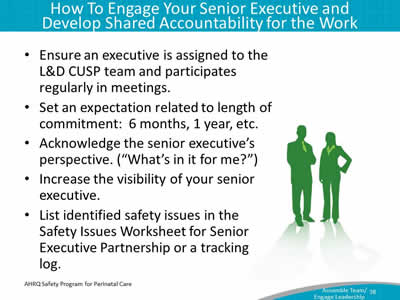
Say:
Just as it is critical to detail the responsibilities of the senior executive, it is equally important for CUSP team leaders to realize how to engage the senior executive while developing shared accountability among the team. This may be difficult to do. Executives and frontline providers serve different roles within the hospital. As a result, their interest in and the skills they contribute to the CUSP initiative will vary.
Set an expectation related to length of commitment, for example 6 months, 1 year, et cetera.
Present the senior executive with the benefits of his or her participation in the project. Remember to appeal to his or her interests both in maintaining patient safety and in the financial gains that will result from participating in the CUSP initiative. Provide statistics that show the positive effects of the CUSP initiative in the areas surrounding patient harm and the average cost per occurrence for the hospital.
An easy way to increase the visibility of the CUSP team's senior executive is to post that person's photo and name on a bulletin board. By doing so, you create a tool for all staff members to readily identify their senior executive team member. Another way is to ask the senior executive to attend a getting-to-know-you interview. To accommodate everyone's schedule, this interview can be completed by one staff member, and the responses can be shared with the L&D unit team.
The senior executive should meet with the CUSP for L&D team regularly and be included in any project-related communications. Recruiting executives in these initiatives forges bonds and improves communication among hospital staff, which will ultimately increase patient safety and reduce unnecessary expenses and harm.
List identified safety issues
One of the most effective approaches to bridging the gap between senior management and frontline providers is to conduct executive safety rounds. During these rounds, executive team members mingle with staff on the L&D unit while discussing safety issues. The importance of these interactions taking place in the L&D unit is twofold. First, unit-based gatherings offer the executive the opportunity to gain a greater understanding of project ownership and cultivate a sense of their integral role within the unit team. Second, meeting on the L&D unit floor also increases senior executive visibility among frontline staff and imparts a stronger impression of commitment to the project. As a team, the executive and other team members can investigate a staff-identified safety defect listed on the Learning From Defects Tool or the Safety Issues Worksheet for the Senior Executive Partnership. This unit wide interest in patient safety will enhance the likelihood of executive participation and engagement in the initiative and will, in turn, improve work culture.
Slide 39: The Nurse Manager's Role
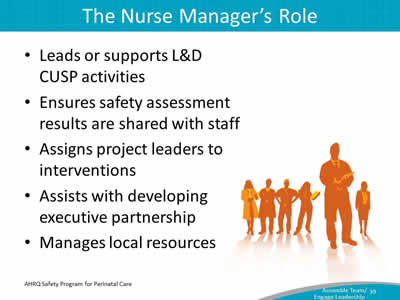
Say:
CUSP teams should also include the nurse manager. The nurse manager partners with the L&D unit team and takes an active role in the CUSP initiative, perhaps even leading the CUSP team efforts. The nurse manager on the CUSP team:
- Supports or leads CUSP activities on L&D.
- Ensures staff safety assessment results are shared with staff.
- Assigns leaders to interventions.
- Assists with developing executive partnership.
- Manages local resources.
The nurse manager supports CUSP activities by communicating the team's needs to the L&D unit nurses. The nurse manager is likely the nurse opinion leader; accordingly, he or she already serves as the key contact for the L&D unit nurses, helps empower the unit nurses throughout the initiative, and integrates CUSP principles and tools into the unit's workflow. The nurse manager makes sure the staff safety assessment results are shared with hospital staff and the unit nurses' findings are shared with the CUSP team at meetings.
Nurse managers also oversee the distribution and maintenance of local resources. These resources may include staff time, supplies, or education and training, all of which greatly influence the outcome of the initiative.
Ask:
Can you identify a nurse manager at your hospital who fits these characteristics and would be a good candidate to participate in a CUSP team?
Slide 40: The Leadership and Management Roles of the Nurse Manager
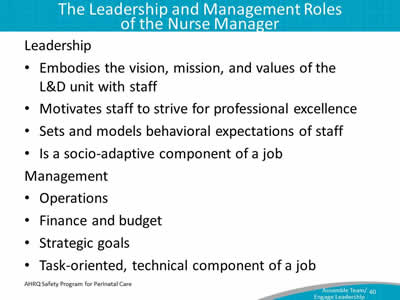
Say:
Nurse managers lead their L&D unit staff by providing their vision for the unit's progress toward excellence. Nurse managers are the change agents for the unit and make decisions that guide the unit's activities. They work closely within their unit to inspire, motivate, and engage administrators, unit staff, and customers.
Nurse managers must manage all unit functions that affect patient care and must embody the skill sets needed to be effective leaders and managers.
As leaders, nurse managers—
- Embody the vision, mission, and values of the unit and share these with staff.
- Motivate staff to strive for professional excellence.
- Set and model behavioral expectations of staff.
In their leadership role, nurse managers use a socio-adaptive skill set that encourages the use of teaching, coaching, and Just Culture principles to engage unit staff and support unit-based initiatives by ensuring close working relationships among unit team members.
As managers, nurse managers deal are responsible for—
- Unit operations.
- Finances and budgets for the unit.
- Strategic goal achievement.
Nurse managers in their management roles use a task-oriented, technical skill set. This skill set enables nurse managers to support the unit's work through working with the team to ensure the team has the necessary resources and materials needed to initiate and sustain their intervention.
Embodying these leadership and management skill sets in their daily work helps nurse managers successfully lead and manage the activities that take place on their unit while supporting the quality improvement work of their staff.
Slide 41: Frameworks Useful for Nurse Managers
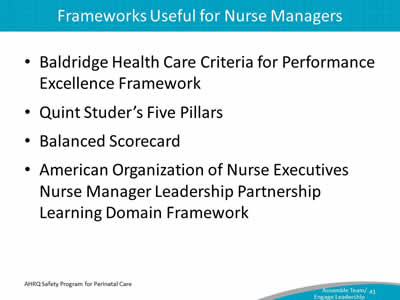
Say:
Hospitals, as businesses, employ frameworks to increase efficiency and quality of care. Some frameworks commonly seen in or adapted for health care include The Malcolm Baldridge Health Care Criteria for Performance Excellence and Quint Studer's Five Pillars. These frameworks are proven in both the nursing and business worlds and deliver a results-driven protocol for nurse managers to follow when putting into effect business and health care quality improvement initiatives on their units. Nurse managers can support their L&D unit's CUSP work through using other quality improvement frameworks. Using additional frameworks provides nurse managers with an additional reference point to gauge the success of the CUSP for L&D intervention and align the unit's work with it.
Slide 42: The Patient Safety Coordinator's/Officer's Role
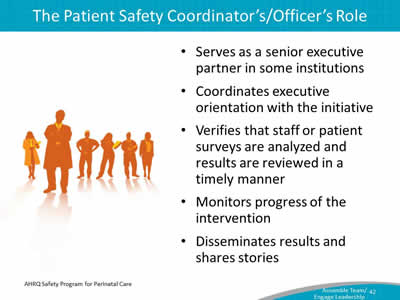
Say:
In addition to the senior executive and nurse manager, CUSP teams may also include the patient safety coordinator or patient safety officer. The patient safety coordinator or patient safety officer supports the goals of the CUSP to guarantee that it is patient centered.
The patient safety coordinator helps develop and sustain the initiative by coordinating executive orientation. Because these staff members are executives in some institutions, their ties with the hospital's executive branch may also advance the goals and needs of the initiative among hospital executives. These individuals are able to apply their clinical and executive statuses to bridge the gap between these fields within the hospital, increasing communication and opportunities for cross-training between the fields.
The patient safety coordinator also assists the CUSP team by ensuring the timely analysis and sharing of staff and patient survey results with the team, staff members, and senior executives hospital wide. In serving as another link between the clinical and executive branches of the hospital, the patient safety coordinator monitors the intervention's progress and presents the L&D unit teams and executive team with a nonbiased assessment of the project. The patient safety coordinator also disseminates results and shares stories.
Ask:
Can you identify a potential patient safety coordinator or officer at your hospital who fits these characteristics and would be a good candidate to participate in a CUSP team?
Slide 43: Psychological Safety
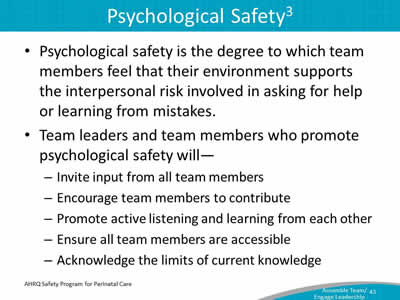
Say:
Once the CUSP team forms, team members must all feel supported in sharing ideas with team members. Psychological safety is a term that describes the psychological security of team members when they interact within the group.
Psychological safety involves all team members—
- Proactively inviting everyone's input by giving permission and encouragement to speak up.
- Listening and learning from each other.
- Being accessible.
- Acknowledging the limits of their current knowledge.
Slide 44: Psychological Safety
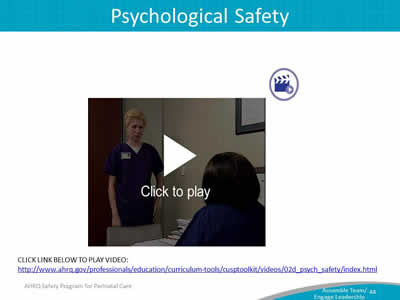
Do:
Play the video.
https://www.ahrq.gov/hai/cusp/videos/02d-psych-safety/index.html
Ask:
- Why does the nurse manager meet with the nurse assistant?
- How does the nurse manager encourage the nurse assistant to speak up while participating on the project?
- Why is psychological safety important when working within a project team?
Slide 45: Assemble the Team: What the Team Needs To Do
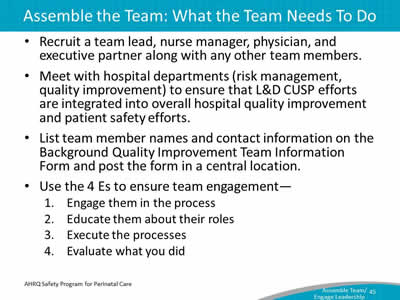
Say:
Several actions contribute to the CUSP team's success. First, team leaders must get the right people to the table. Team leaders should recruit a nurse manager, a physician champion, and a senior executive. Health care providers from the L&D unit who will be engaged should also be actively recruited.
Key hospital departments, such as risk management, quality improvement, and infection prevention, that may have an interest in the work of the CUSP team should be included to integrate CUSP efforts into overall hospital quality improvement and patient safety efforts.
Team members' names and their contact information should be listed on the Background Quality Improvement Form, which should be posted in a central location.
Team leads should remember to use the 4 Es when recruiting CUSP team members:
- Engage team members in the process.
- Educate them about their roles.
- Execute the processes.
- Evaluate what was accomplished.
Slide 46: CUSP Tools
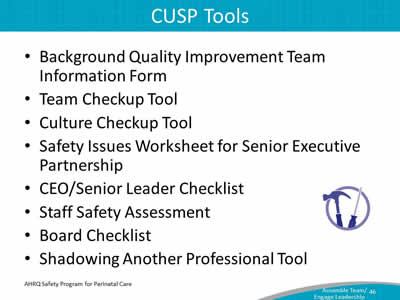
Say:
In addition to the information presented in this module, CUSP tools available through the Safety Program for Perinatal Care will help clarify the roles and responsibilities of the team and assess unit team culture.
Background Quality Improvement Team Information Form
The Background Quality Improvement Team Information Form will help the L&D unit team identify L&D CUSP team members in the L&D unit. Team members completing this form are committing—in writing—to their role on the CUSP team. In addition to outlining assignments, the document contains staff contact information to encourage interaction among the CUSP team members and promote teamwork.
Culture Checkup Tool
The Culture Checkup Tool will help the L&D unit team address problems identified in the unit patient safety culture assessment. This tool aids in the understanding of unit culture and will help the CUSP team carry out interventions to improve the local culture. With the tool, L&D unit teams review the patient safety culture results to identify potential barriers and strengths team members can use as a basis for making culture and patient safety improvement decisions. Focusing the culture conversation on group-level data depersonalizes the discussion and fosters improvement in the context of the local realities of care delivery. The team can use the tool to target a goal for improvement shortly after the culture assessment and every 3 to 6 months, or as needed, to encourage culture conversations, evaluate cultural issues between survey administrations, and monitor the progress of culture change.
Safety Issues Worksheet for Senior Executive Partnership
The Safety Issues Worksheet for Senior Executive Partnership is a document that helps L&D unit teams and their executive team member discuss provider-identified safety issues that require an executive intervention.
CEO/Senior Leader Checklist
The CEO/Senior Leader Checklist helps the senior executive assign project responsibilities and standardize the roles of L&D unit team members who are participating in the CUSP initiative. This checklist accounts for all the necessary tasks the CUSP team needs to complete to ensure the success and sustainability of the CUSP initiative.
Staff Safety Assessment
The Staff Safety Assessment helps the senior executive collaborate with frontline providers to identify and understand possible risks within the unit. Frontline providers complete this assessment, highlighting areas of concern for the senior executive to address with the L&D unit team.
Board Checklist
The Board Checklist is meant to engage members of the hospital board in the CUSP initiative. It facilitates the completion of a strategic safety plan that can be used in the L&D unit. Items on this checklist also help guide the board in developing the means to assess, review, and improve culture within the L&D unit. Additionally, checklist items help facilitate the completion of tasks on the CEO/Senior Leader Checklist.
Shadowing Another Professional Tool
The Shadowing Another Professional Tool allows L&D unit team members to examine and understand the cultural differences that exist among various professions. Executives and clinicians approach issues very differently, and using this tool helps provide a better insight into colleague work culture and how other team members approach similar issues. This permits L&D unit teams to engage each other in projects and tasks based on the knowledge gained from shadowing their peers and learning about diverse jobs and attitudes.
Slide 47: Summary
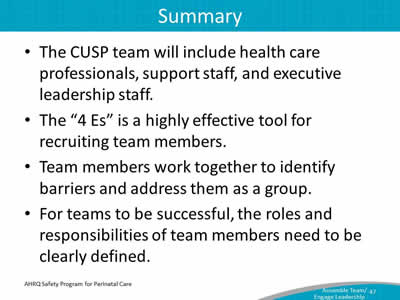
Say:
The CUSP team should have representatives from providers and nurses, support staff, and executive leadership staff.
Team leads should keep the 4 Es in mind when recruiting team members: engage, educate, execute, and evaluate.
The CUSP team should work as a group to identify barriers and solutions.
Each team member's role must be clearly defined.
Slide 48: References
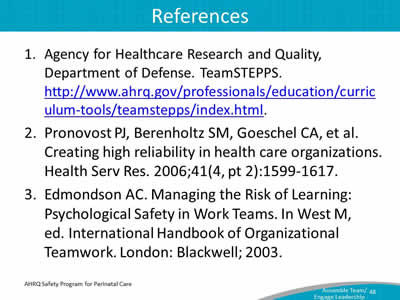
Slide 49: Disclaimers
